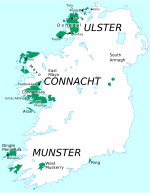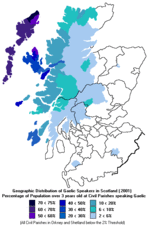- Gaels
-
"Gael" redirects here. For the village in France, see Gaël.
 Britain & Ireland in the mid-5th century CE, between the Roman departure and the founding of Anglo-Saxon kingdoms.
Britain & Ireland in the mid-5th century CE, between the Roman departure and the founding of Anglo-Saxon kingdoms. Mainly Goidelic areas.Mainly Pictish areas.Mainly Brythonic areas.Gaelic language and culture would eventually become dominant in the Pictish area and far northern Brythonic area.
Mainly Goidelic areas.Mainly Pictish areas.Mainly Brythonic areas.Gaelic language and culture would eventually become dominant in the Pictish area and far northern Brythonic area.The Gaels or Goidels are speakers of one of the Goidelic Celtic languages: Irish, Scottish Gaelic, and Manx.[1] Goidelic speech originated in Ireland and subsequently spread to western and northern Scotland and the Isle of Man.
The Goidelic languages are one of the two branches of the Insular Celtic languages, the other being Brythonic.
Contents
Terminology
The modern English term Gael derives ultimately from the Old Irish (Ancient Gaelic) word Goídel, which was spelled in various ways by Gaelic writers at different times. The modern Gaelic spellings are Gael (Irish) and Gàidheal (Scottish Gaelic).
Early Greek and Roman authors called the Irish Ιουερνοι and Iverni, respectively, both derived from the Proto-Irish ethnic name *Iwerni ("people of *Iweriū"). Later Greek and Latin variants of this name included Ίερνοι, Hierni, and Hiberni.[2]
Scoti or Scotti was another generic Latin name for the Irish that came into use by the 4th century AD.[3][4] It is not believed that any Gaelic groups called themselves Scot(t)i in ancient times, except when referring to themselves in Latin.[3] It is also conjectured that the Latin term may mean "raider/pirate" as it is widely accepted that raiders from Ireland were attacking Britain's west coast during and following the Roman occupation.
Goidel is thought to have been borrowed sometime during the 7th century AD from Primitive Welsh Guoidel, "Irishman", (which is attested as a male personal name in the Book of Llandaff) and may ultimately be derived from an Proto-Indo-European *weidh-(e)l-o-, perhaps meaning "forest people," partially cognate with the Old Irish ethnic name Féni (from Proto-Indo-European *weidh-n-jo-, "forest people," later becoming simply "warriors" in Proto-Irish).[5][6]
History of use
Since the disappearance of Gaelic as a community language in the south and east of Scotland in the late medieval period, and the popularity of the terms 'highland Scot' and 'lowland Scot', the term Gàidheal has been used in Gaelic language conversation not merely to denote Gaelic identity but also as an equivalent for the single English word 'highlander'.
Up until the late 15th century, the Gaelic language in Scotland was generally named Scottish, both in its Latin form and in Early Scots. For example, the usage in The Flyting of Dumbar and Kennedie at the start of the 16th century is Erse (= Irish) and Inglis (= English). After this time, the Gaelic language generally became called Erse (Irish) and the lowland tongue Scots (= Scottish).
Documentary evidence shows other subsequent alterations in general terminology, such as the appearance of the Latin term "Scotos Hibernicos" in 1521 and its English equivalent, "Scottish-Irish," by the English diplomat Ralph Sadler in 1558 to refer to Scottish Gaels.[7]
In earliest surviving writings in the Lowland Scots tongue (which had hitherto been called Inglis), a form of the term Gaidheal appears to discriminate between Gaels from the Scottish Highlands and Gaels from Ireland. In 1596, it appears in James Dalrymple's translation from Latin into Lowland Scots of the Historie and Chronicles of Scotland, 1436–1565 as the main element within the word Gaelic, referring to the language in Scotland, rather than in Ireland.
Current definitions
- Gaels – the ethno-linguistic group.
- Gaelic – of or relating to the Gaels.
- Goidels – an alternative term sometimes used to describe the Gaels in antiquarian contexts
- Goidelic – of or relating to the Gaels, particularly their language, in antiquarian contexts
Gaelic culture and society
Main articles: Gaelic Ireland and Culture of Scotland in the High Middle AgesHistory
Mythological origins
Main articles: Early history of Ireland and Milesians (Irish)The Gaels, during the beginning of the Christian era, believed themselves to be descendants of the Milesians - the sons of Míl Espáine. Much of this is covered in the Lebor Gabála Érenn, which catalogues the Milesian invasion of Ireland from the Iberian Peninsula. While this account is mostly mythic, it may be an embellished version of actual historical events. Recent genetic studies by Brian Sykes, Oxford University, suggest that these myths are based on historical facts since the people of northwestern Iberia, especially those from Galicia and Asturias are genetically closely related to the Gaels.
Emergence of Gaelic language
 The vowels of the Ogham alphabet.
The vowels of the Ogham alphabet. Main articles: Primitive Irish and Old Irish
Main articles: Primitive Irish and Old IrishIt is not known with any certainty when the Goidelic (or Q-Celtic) language developed in prehistoric Ireland, or how the Gaels came to be the dominant culture.
Estimates of the arrival of proto-Gaelic in Ireland vary widely from the introduction of agriculture circa 7000-6000 BC to around the first few centuries BC. Little can be said with certainty, as the language now known as Old Irish, ancestral to modern Irish, Scots Gaelic and Manx, first began to be properly recorded with the Christianisation of Ireland in the 4th Century AD, with the introduction of the Roman script. Old Irish does appear in a specialized written form, using a unique script known as Ogham. The oldest examples of Ogham have survived in the form of memorial inscriptions or short epitaphs on pillar-like stone monuments (see Mac Cairthinn mac Coelboth.) Ogham stones are found throughout Ireland as well as in other areas where Gaelic invaders settled across post-Roman Britain. This form of written Old Irish is thought to have been in use as early as 1000 BC. The script frequently encodes a name or description of the owner and surrounding region, and it is possible that the inscribed stones may have represented territorial claims.
Expansion
 Red: Historical maximum expansion of known Gaelic-speaking areas in the British Isles
Red: Historical maximum expansion of known Gaelic-speaking areas in the British Isles
Orange: Other areas where ogham inscriptions have been found
Green: Areas where Goidelic languages are commonly spoken in modern timesStarting sometime around the 5th century Gaelic language and culture spread from Ireland to the southwest coast of modern Scotland, where it may have already existed since Roman times. Uncertainty over this comes as a result of the fact that there is disputed archaeological evidence to support the generally accepted tale of migration while there is some to suggest that there was none — the evidence also points to the population of the area (modern day Argyll) being constant during the time of the alleged invasion of Scotland[citation needed]. This area was known as Dál Riata. The Gaels soon spread out to most of the rest of the country. Culturo-linguistic dominance in the area eventually led to the Latin name for Gaelic speaking peoples, "Scoti," being applied to the state founded by the Gaels: "Scotland." Since that time Gaelic language rose and, in the past three centuries, greatly diminished, in most of Ireland and Scotland. The most culturally and linguistically Gaelic regions are in the north west of Scotland, the west of Ireland and Cape Breton Island in Nova Scotia where the descendants of the Highland Clearances were transplanted.
The Isle of Man (Manx: Ellan Vannin, 'Mannin's Isle', from the pre-Christian deity known as Manannán mac Lír) also came under massive Gaelic influence in its history. The last native speaker of Manx died in the 1970s, though use of the Manx language never fully ceased. There is now a resurgent language movement and Manx is once again taught in all schools as a second language and in some as a first language. A large part of the island's cultural heritage is Gaelic.
Today
 Gaeltacht areas in Ireland.
Gaeltacht areas in Ireland.
The two comparatively 'major' Gaelic nations in the modern era are Ireland (which in the 2002 census had 185,838 people who spoke Irish "daily" and 1,570,894 who were "able" to speak it).[8] and Scotland (58,552 "Gaelic speakers" and 92,400 with "some Gaelic language ability"[9] in the 2001 census) Communities where the language is still spoken natively are restricted largely to the west coast of each country and especially the Hebrides in Scotland. However, a large proportion of the Gaelic speaking population now lives in the cities of Glasgow and Edinburgh in Scotland, as well as Donegal, Galway, Cork and Dublin in Ireland. There are somewhere around 2,000 Canadian Gaelic speakers although they are generally of a very advanced age and concentrated in Nova Scotia and Cape Breton Island.[10] According to the 2000 US CensusPDF (123 KiB), there are over 25,000 Irish-speakers in the United States with the majority found in urban areas with large Irish-American communities such as Boston, New York City and Chicago.
See also
References
- ^ "Gael" is often used specifically for Scottish Gaelic speakers. "Goidels" was advanced by John Rhys in Early Britain (1882) as a blanket term for all speakers of a Goidelic tongue, and has been used commonly in Celtic studies. See "Goidel". Oxford English Dictionary. December 1989. http://dictionary.oed.com.dax.lib.unf.edu/cgi/entry/50096518?single=1&query_type=word&queryword=Goidel&first=1&max_to_show=10. Retrieved April 14, 2010..
- ^ Koch, John (ed). Celtic Culture: a historical encyclopedia, ABC-CLIO, 2006, pp. 709-710; p. 846; p. 848
- ^ a b Online Etymology Dictionary: "Scot"
- ^ Koch, John (ed). Celtic Culture: a historical encyclopedia, ABC-CLIO, 2006, p. 846
- ^ Koch, John. The Goddodin of Aneirin, Celtic Studies Publications, 1997, pg. xcvii, note 2)
- ^ Koch, John (ed). Celtic Culture: a historical encyclopedia, ABC-CLIO, 2006, p. 739
- ^ [1]
- ^ Central Statistics Office Ireland - Irish ability, persons aged 3 years and over.
- ^ General Register Office, Scotland's Census 2001, Gaelic Report
- ^ Oifis Iomairtean na Gaidhlig/Office of Gaelic Affairs
External links
- Aberdeen University Celtic Department Information and courses on all aspects of Celts, Gaels and related peoples, languages and cultures
- Iomairt Cholm Cille (The Columban Institute) An institute with the aim of promoting links between Irish and Scottish Gaelic speakers.
- DNA shows Scots and Irish should look to Spain for their ancestry
Celts Ancient Celts
Celtic studiesPlacesGaelic Ireland · Dálriata / Alba · Iron Age Britain / Roman Britain / Sub-Roman Britain ·
Iron Age Gaul / Roman Gaul · Galatia · Gallaecia · Britonia · Balkans · TransylvaniaReligionSociety
Modern Celts
Celtic RevivalLanguages Proto-Celtic · Insular Celtic (Brythonic · Goidelic) · Continental Celtic (Celtiberian · Gaulish · Galatian · Gallaecian · Lepontic · Noric)Festivals Lists Celts · Tribes · Deities · English words of Celtic origin · Spanish words of Celtic origin · Galician words of Celtic origin · French words of Gaulish originCategories:- Gaels
- Celtic culture
- Ethnic groups in Ireland
- Ethnic groups in the United Kingdom
- Manx society
- Scottish Gaelic-speaking people
Wikimedia Foundation. 2010.

